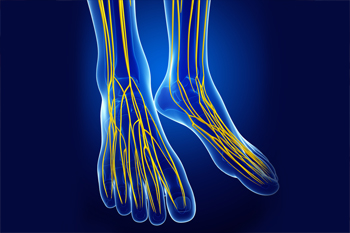Dallas (214) 340-8885
Athens (903) 677-9090
Gun Barrel City (903) 887-4341
Dallas (214) 340-8885
Athens (903) 677-9090
Gun Barrel City (903) 887-4341
 Tarsal tunnel syndrome occurs when the posterior tibial nerve, located near the inside of the ankle in a structure called the tarsal tunnel, is compressed. This can occur due to osteoarthritis, ankle trauma, or tenosynovitis. The posterior tibial nerve may also be compressed by an enlarged or abnormal structure in the tarsal tunnel, such as a cyst. Tarsal tunnel syndrome is associated with rheumatoid arthritis and diabetes, which can cause swelling and, as a result of swelling, nerve compression. People with flat fat are also at an increased risk of getting tarsal tunnel syndrome due to gait patterns that put more strain on the nerve. Tarsal tunnel syndrome causes symptoms such as numbness, tingling, or burning sensations and shooting pains in the ankle. If you believe that you may be suffering from tarsal tunnel syndrome, please consult with a podiatrist.
Tarsal tunnel syndrome occurs when the posterior tibial nerve, located near the inside of the ankle in a structure called the tarsal tunnel, is compressed. This can occur due to osteoarthritis, ankle trauma, or tenosynovitis. The posterior tibial nerve may also be compressed by an enlarged or abnormal structure in the tarsal tunnel, such as a cyst. Tarsal tunnel syndrome is associated with rheumatoid arthritis and diabetes, which can cause swelling and, as a result of swelling, nerve compression. People with flat fat are also at an increased risk of getting tarsal tunnel syndrome due to gait patterns that put more strain on the nerve. Tarsal tunnel syndrome causes symptoms such as numbness, tingling, or burning sensations and shooting pains in the ankle. If you believe that you may be suffering from tarsal tunnel syndrome, please consult with a podiatrist.
Tarsal tunnel syndrome can be very uncomfortable to live with. If you are experiencing tarsal tunnel syndrome, contact Dr. Jonathan Kletz of Texas Foot Works. Our doctor can provide the care you need to keep you pain-free and on your feet.
Tarsal Tunnel Syndrome
Tarsal tunnel syndrome, which can also be called tibial nerve dysfunction, is an uncommon condition of misfiring peripheral nerves in the foot. The tibial nerve is the peripheral nerve in the leg responsible for sensation and movement of the foot and calf muscles. In tarsal tunnel syndrome, the tibial nerve is damaged, causing problems with movement and feeling in the foot of the affected leg.
Common Cause of Tarsal Tunnel Syndrome
The Effects of Tarsal Tunnel Syndrome
A physical exam of the leg can help identify the presence of tarsal tunnel syndrome. Medical tests, such as a nerve biopsy, are also used to diagnose the condition. Patients may receive physical therapy and prescriptive medication. In extreme cases, some may require surgery.
If you have any questions please feel free to contact one of our our offices located in Dallas, Athens, and Gun Barrel City, TX . We offer the newest diagnostic and treatment technologies for all your foot and ankle needs.
Make sure you enter all the required information, indicated by an asterisk (*). HTML code is not allowed.